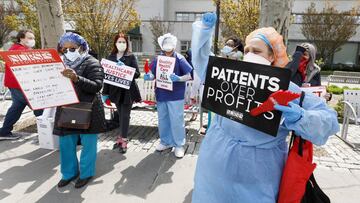How much does a nurse earn in the US per hour: what is the average LPN/LVN salary?
The importance of healthcare workers has been demonstrated throughout the pandemic, but some are surprised to learn how low nurses’ salaries can be.


The United States is currently in the midst of a critical nursing shortage, caused in part by the huge strain placed on nurses and the healthcare system more broadly during the pandemic.
However the current nursing shortage was identified back in 2012 and the factors at play go far beyond the more recent global situation. Nurses in the US earn far less on average than their counterparts in Canada, for example, and qualified nurses in some states can expect to make just $18 per hour.
In 2020 the Bureau of Labor Statistics found that the average annual salary for Licensed Vocational Nurses (LVN) and Licensed Practical Nurses (LPN) is $50,090 per year. This works out at $24.08 per hour.
Only the top 10% of LPN and LVN nurses earn more than $65,000 per year, or $31.50 per hour.
The earnings in different states varies greatly too. The highest earners are found in Alaska where the average annual pay is $67,620 ($32.51 per hour). In West Virginia that average figure drops to $38,940, little more than half that of their Alaskan counterparts, for an average hourly rate of $18.72.
Typical salaries also vary depending between different types of nursing jobs. A Certified Nursing Assistant (CNA) gets paid $32,050 per year on average ($15.41 per hour). If you get an associate degree in nursing or bachelor of science in nursing then you can become a registered nurse, who earn $80,010 on average ($38.47 per hour).
Nursing shortage predicted to continue until 2030
Since the early 1900s the United States has suffered numerous periodic nursing shortages. Often these were spurred by a single event, such as a recession or world war, but the current nursing crisis is part of a broader problem.
As life expectancies have increased and the population has skewed older, the demand for nurses and healthcare in general has never been higher. The baby boomer generation (born between 1946 and 1964) are entering into old age and the nation now has more people aged 65 or older than at any point in its history.
The US health-care system needs more nurses. Nursing schools aren’t producing enough graduates, young workers are quitting, and older ones are retiring early.
— Bloomberg Opinion (@opinion) October 19, 2022
Widespread shortages reduced the quality of care during Covid-19 https://t.co/PWTyuFAQOx
In 2011 there were 41 million people aged 65+; by 2019 that figure had risen to 71 million.
Related stories
Healthcare has also become more accessible and more affordable, meaning that the proportion of people entitled to support has also grown. While these two trends – longer life expectancies and greater availability of healthcare – are undoubtedly positive, the failure to add the required trained staff to the healthcare system could prove costly in the years to come.
A study from the University of St. Augustine for Health Sciences found that the US would need an additional 1.2 million new registered nurses by 2030 to address the shortage. Failing to do so could leave vulnerable patients unable to get the support they need and could push up the price of coverage significantly.

